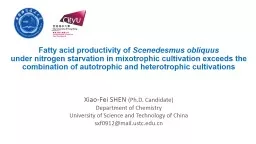

Scenedesmus obliquus under nitrogen starvation in mixotrophic cultivation exceeds the combination of autotrophic and heterotrophic cultivations XiaoFei SHEN PhD Candidate Department of Chemistry ID: 813620
Download The PPT/PDF document "Fatty acid productivity of" is the property of its rightful owner. Permission is granted to download and print the materials on this web site for personal, non-commercial use only, and to display it on your personal computer provided you do not modify the materials and that you retain all copyright notices contained in the materials. By downloading content from our website, you accept the terms of this agreement.
Slide1
Fatty acid productivity of Scenedesmus obliquus under nitrogen starvation in mixotrophic cultivation exceeds the combination of autotrophic and heterotrophic cultivations
Xiao-Fei SHEN (Ph.D. Candidate)Department of ChemistryUniversity of Science and Technology of Chinasxf0912@mail.ustc.edu.cn
Slide2Content
2. Materials and Methods
3. Results and discussion
4. Conclusions
1. Background
Slide3Content
3. Results and discussion
4. Conclusions
1. Background
2. Materials and Methods
Slide4University of Science and Technology of China1.Background-Comercial production obstacle
Select species
Cultivation
Oil extraction and
transesterification
Nutrient, light, water, carbon source
Lipid productivity
Biomass productivity
Lipid content
Harvest
Background
Biodiesel
Slide5University of Science and Technology of China
Nitrogen starvation
Lipid productivity decrease
The effect of P concentration on biomass and lipid productivities of microalgae under nitrogen starvation conditions
Role of phosphorus
Slide6Autotrophic cultivation of S. obliquus
FAME productivity:
N
starvation
conditions >
N sufficient
conditions;
N-
&P > N-&P-
lim
> N-&
P-
Bioresource
Technology
. 2014, 152: 241–246
Slide7Both
the highest FAME productivity and FAME yield were also obtained under N-&P.
FAME
productivity under nitrogen starved conditions increased fourfold than that under nitrogen sufficient conditions.
Applied
Energy
. 2015, 158: 348–354
Heterotrophic cultivation of
S. obliquus
with acetate
55.9mg/L/d
Slide8The cell concentration and lipid production of mixotrophic Chlorella sp. was even higher than the sum of those from photoautotrophic and heterotrophic culture.The lipid production of Chlorella vulgaris under mixotrophic cultivation was lower than under heterotrophic cultivation due to the unsatisfactory lipid content (13.8%) of mixotrophic culture
Whether
oil production from
mixotrophic
culture can
exceed
the sum of those from
autotrophic
and
heterotrophic
culture
?
Contradictory conclusions
from previous studies
Influence factors?
Algae species
and
carbon source
Nitrogen starvation
can significantly increase the lipid content and the lipid productivity of microalgae in both autotrophic and heterotrophic systems
Mixotrophic cultivation
Scenedesmus obliquus
Acetate
Nitrogen starvation
Slide9Content
3. Results and discussion
4. Conclusions
1. Background
2. Materials and Methods
Slide10Algae species: Axenic Scenedesmus obliquus
NIES-2280Basic medium: BG-11 medium5 g·L
-1
sodium acetate
was added as organic
carbon source
Nitrogen
source was removed from the
media
Phosphorus
concentration:
40
mg·L
-1 (
Sufficient)
Proteomics analysis
: the isobaric tags for the relative and absolute quantitation technique (iTRAQ)
Materials and Methods
Slide11Calculation of biomass productivity
and fatty acid productivity
Slide12Calculation of fatty acid yield
Slide133. Results and discussion
Content
2. Materials and Methods
4. Conclusions
1. Background
Slide14During the whole cultivation period, the biomass productivities of the mixotrophic culture exceeded the combination of the autotrophic and heterotrophic cultures.These two absorption curves are very similar, and no significant difference was found between the assimilation rates from the heterotrophic and mixotrophic cultures
Slide15At the end of the experiment, the fatty acid contents of the autotrophic, heterotrophic, and mixotrophic cultures were 19.7, 46.7, and 58.3%, respectively. The
highest fatty acid content was obtained in the mixotrophic culture. The fatty acid content of all the three groups rose steadily and significantly.
Slide16C18:1 was the most predominant composition, accounting for 52.8% and 66% of the total fatty acids in the mixotrophic and heterotrophic cultures, respectively.The highest unsaturated fatty acid content was obtained in mixotrophic culture
Slide17The protein contents of all the three systems decreased significantly during the cultivation period The lowest protein content was obtained in the mixotrophic culture; it declined sharply from 55.6% to 9.1% during the nine-day cultivation period.
No significant difference was observed between the results for the heterotrophic and mixotrophic cultures
Slide18Fatty acid productivity (mg/L/d)
Fatty acid yieldAutotrophic14.7±2.1
-----Mixotrophic
118.4±6.4
0.45±0.04*
Heterotrophic
57.5±5.3
0.23±0.02
Note: the fatty acid produced through autotrophic process has been deducted.
More
assimilated acetate is directed to lipid synthesis rather than protein and starch accumulation with the presence of light and supply of CO
2
.
Slide19Proteomics analysis
1,065 proteins were identified299 proteins had significant changes in the expression levelSome proteins participated in growth and lipid synthesis processes
Slide20Slide21AccessionBiological process
Protein namePeptides (95%)Fold change
CV
Expression
A8IWA6
Growth
Glutamate synthase, NADH-dependent
15
1.71
0.10
Up-regulated
A8HNQ7
Lipid metabolism
Thioredoxin reductase
1
2.42
0.37
Up-regulated
A8IRQ1
Lipid metabolism
Ribose-5-phosphate isomerase
7
1.77
0.01
Up-regulated
A8JGJ6
Lipid metabolism
Mg protoporphyrin IX S-adenosyl methionine O-methyl transferase2
1.77
0.04
Up-regulated
A8J2S0
Small molecular metabolism
Citrate synthase
3
2.74
0.10
Up-regulated
A8J0R7
Generation of precursor metabolites and energy
Isocitrate dehydrogenase
1
2.60
0.14
Up-regulated
A0A0D2K714
Carbohydrate metabolism
Pyruvate kinase
15
2.17
0.09
Up-regulated
B6E5W6
Carbohydrate metabolism
Glucose-6-phosphate isomerase
9
1.71
0.10
Up-regulated
A0A0D2NR30
Catabolic process
Glycerol-3-phosphate dehydrogenase
2
2.52
0.23
Up-regulated
A8I8Z4
Lipid metabolism
Ribosomal protein
2
0.59
0.10
Down-regulated
A8IKQ0
Lipid metabolism
Fructose-1,6-bisphosphatase
4
0.52
0.22
Down-regulated
D8TTF7
Lipid metabolism
Plastid acyl-ACP desaturase
2
0.15
0.22
Down-regulated
A0A0D2JX51
Small molecular metabolism
Malate dehydrogenase
16
0.65
0.19
Down-regulated
Q4U1D9
Biosynthetic process
Soluble starch synthase III
3
0.58
0.10
Down-regulated
Q8VXQ9
Carbohydrate metabolism
Glyceraldehyde-3-phosphate dehydrogenase A, chloroplast
20
0.24
0.48
Down-regulated
TCA cycle
The
activity of the TCA cycle is improved in mixotrophic culture, resulting in more fatty acid synthesis in
S. obliquus
cells.
Slide22Content
2. Materials and Methods
3. Results and discussion
4. Conclusions
1. Background
Slide23Under nitrogen starvation, the biomass and biodiesel productivities of mixotrophic S. obliquus exceeded the combination of autotrophic and heterotrophic cells when using acetate as carbon source.
The fatty acid yield from mixotrophic culture (0.45) was almost two times greater than for heterotrophic culture (0.23).
Proteomics
analysis revealed that the activity of the
TCA cycle
was improved in mixotrophic culture when compared with heterotrophic
culture.
Conclusions
Slide24Thank You For
Your Attention!